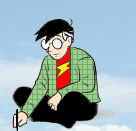Cartoonists are always finding ways to balance their pages. We can’t help it. If there’s a close-up in the lower left, we balance it a little on the upper right. If there are a lot of spot blacks on one page, we find more spots on the other. We’re taught that dynamic balance is more interesting than static balance, but the goal of balance itself remains. Balance can lead to harmonious, satisfying compositions, but is that what comics artists really want? A satisfying page is a page you can stay on, linger on, stop on—a page without momentum.
When we walk, all we’re doing is falling. We fall a little, stop ourselves from falling, then fall a little more. Balance keeps us from falling on our faces, but it’s imbalance that gets us where we’re going.
I wonder: Would it help to forget panel 1 when I draw panel 2, and forget 2 when I draw 3? The result might be an imbalanced mess, but would it also be a more interesting mess? A more surprising, less typical, mess? Would it lead the reader to wonder what the next spread had in store, and feel less confident he/she could predict the shape of each one?
Imbalance already drives stories forward—a character lacks something, the world’s out of joint, trouble’s on the rise—maybe it should also play a more prominent role in storytelling.














 The place I ate lunch at yesterday here in Brussels had a gorgeous display of alcohol bottles rising 14 feet on cherry wood shelves. The bottles were lit from above and below and within each shelf. I spent the entire lunch staring at them.
The place I ate lunch at yesterday here in Brussels had a gorgeous display of alcohol bottles rising 14 feet on cherry wood shelves. The bottles were lit from above and below and within each shelf. I spent the entire lunch staring at them.